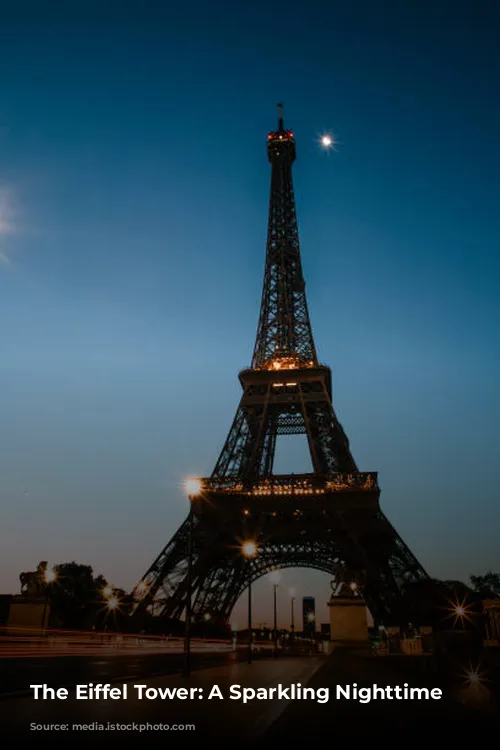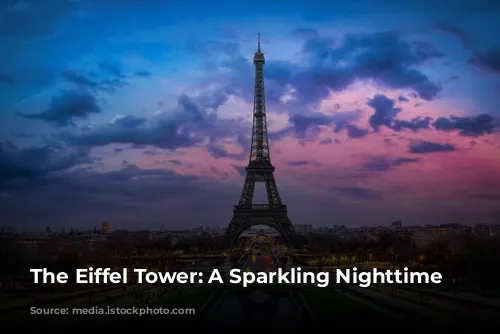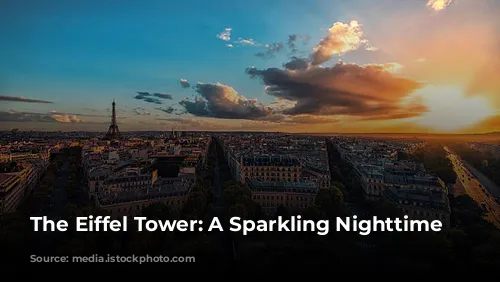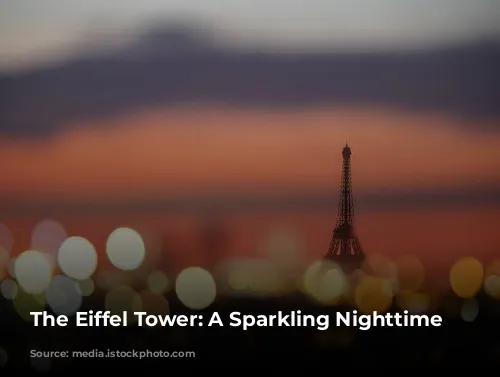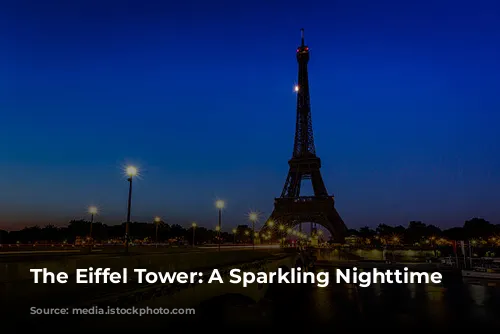Imagine a city bathed in moonlight, a glittering landmark piercing the darkness. This is the Eiffel Tower at night, a transformation from its imposing, daytime presence into a dazzling beacon of light.
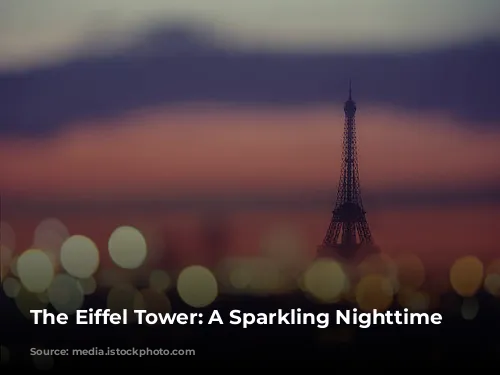
The Twinkle and Lights of the Eiffel Tower
While millions flock to witness the Eiffel Tower’s nighttime brilliance each year, its sparkling facade is a relatively recent addition. The Iron Lady, as she is affectionately known, didn’t always wear this shimmering dress.
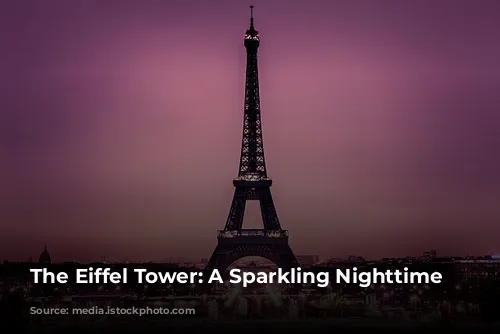
The History of the Eiffel Tower Lighting
Designed by Gustave Eiffel for the 1889 Universal Exhibition, the tower was initially destined for demolition after the event. However, its popularity led to its preservation and subsequent embellishment. On December 31, 1985, the world was introduced to the Eiffel Tower’s golden glow, created by 336 yellow-orange spotlights. This illumination served a dual purpose: to enhance the tower’s elegant curves and to ensure its safety and functionality during the night.
Even before electricity, the tower was equipped with gaslights strategically placed throughout its structure to guide nocturnal visitors.
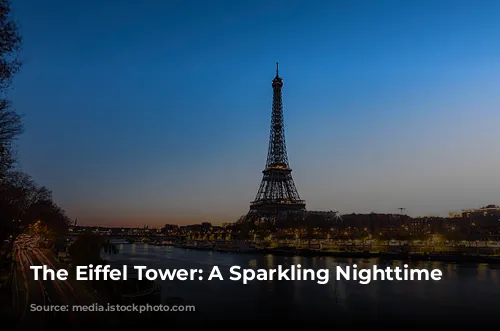
Twinkling of the Eiffel Tower: Times and Operation
If you’re planning a trip to Paris, don’t miss the opportunity to witness the Eiffel Tower’s mesmerizing sparkle. The lighting operates on a meticulously planned schedule, activated by light sensors as darkness descends. While the exact time varies, you can generally count on the tower illuminating as soon as the sun sets.
A continuous golden glow bathes the tower, punctuated by breathtaking flashes at the beginning of each hour, until 11:00 p.m. This mesmerizing spectacle lasts for 5 minutes before the lights completely fade at 11:45 p.m., coinciding with the tower’s closing time.
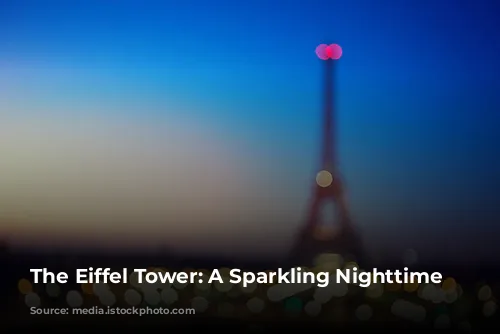
Energy Efficiency and the Eiffel Tower
In response to the Mayor of Paris’ energy conservation initiatives, the Eiffel Tower has undergone a series of modifications to minimize its environmental impact. While the tower’s illuminations once extended until 1:00 a.m., accounting for 4% of its annual energy consumption, the current 11:45 p.m. cut-off represents a symbolic gesture with minimal impact on energy expenditure.
The Eiffel Tower has implemented numerous improvements over the years, including a 40% reduction in projector power in 2004 and the use of energy-efficient xenon lamps for its 20,000 light points.

The Eiffel Tower’s Lighthouse
The dazzling lights and sparkles of the Eiffel Tower are instantly recognizable, but have you ever noticed the lighthouse that crowns its summit and beams across the city?
Initially, the lighthouse’s purpose was to illuminate Paris’s monuments, enhancing the beauty of these poorly lit historical gems. As electric lighting became widespread, the lighthouse’s tourist function diminished, and it was designated as an air navigation landmark in 1947.
Today, the Eiffel Tower’s lighthouse holds a more universal symbolic significance, serving no specific function. Since 2000, it emits two beams with a range of 80 km, twice the length of Paris’s ring road.

Climb to the Top of the Eiffel Tower at Night
If you’ve experienced the Eiffel Tower during the day, you owe it to yourself to visit at night. The nighttime experience is completely different, offering a unique perspective and an unparalleled sense of magic.
The Eiffel Tower’s operating hours vary, so be sure to check the schedule for nighttime access, which is typically available on weekends, during the summer, and during school holidays. Generally, the tower is open until 11:45 p.m. while the stairs are often only accessible until 6:00 p.m., necessitating a lift ride to reach the top.
Don’t rush your nighttime visit! Wait for the sun to set, climb the stairs to the summit, and allow the illuminated tower to transport you to a magical realm. As the last rays of sunlight paint the sky, you’ll catch a glimpse of the breathtaking panoramic views that await you at the top.
Once at the peak, the champagne bar invites you to savor a glass of bubbly while taking in the stunning vista of Paris bathed in the glow of a thousand lights.
For a delectable dining experience, visit Madame Brasserie on the first floor, orchestrated by renowned chef Thierry Marx, or indulge in a fine-dining experience at the Jules Verne on the second floor, where the masterful chef Frédéric Anton reigns supreme.
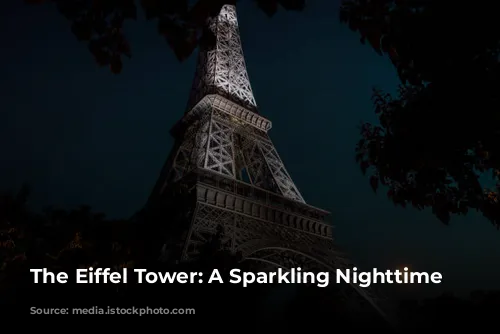
Enjoy the Sparkles During Your Visit
The Eiffel Tower’s sparkles are a captivating sight for anyone strolling by. However, witnessing this spectacle from within the tower elevates the experience to a whole new level.
For the most immersive experience, head to the second floor near the Jules Verne at the beginning of each hour. You’ll be surrounded by the dazzling spectacle of the sparkles for five minutes, feeling the magic of the Eiffel Tower’s illumination like never before.
If you haven’t yet discovered the Eiffel Tower, don’t settle for a daytime visit. Complete your experience by marveling at its beauty under the starry sky. To enhance your stay, book a room with a view of the Eiffel Tower at the Hotel Bleu de Grenelle, and prepare to be captivated by the Iron Lady’s dazzling transformation into a beacon of light.
